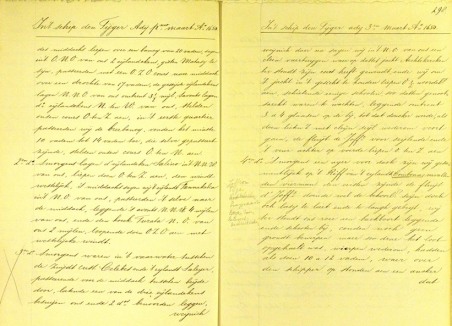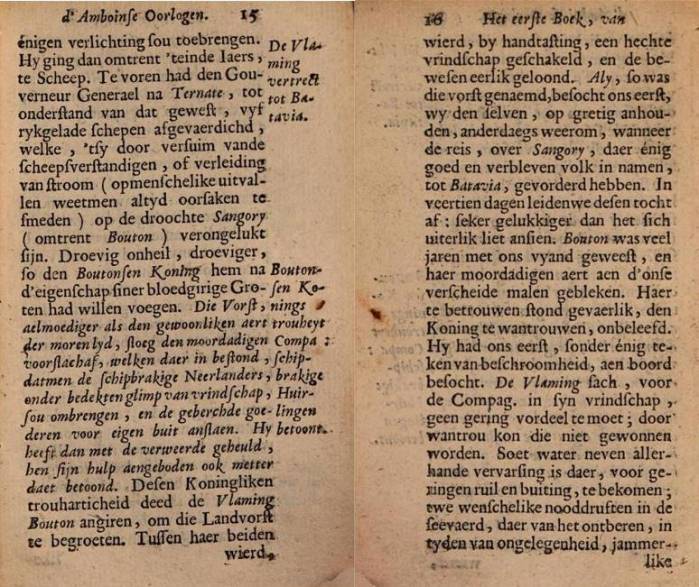February 23, 1650, a fleet of five Dutch vessels, the retourschip Tijger (1000t), the fluyt Juffrouw (or Juffer, 480t), and the yachts Luijpaert (320t), Bergen op Zoom (300t) and Aechtekercke (100t), left Batavia with, as the journal of the events tells us, a load of ‘soldiers, victuals and accoutrements for Ternate’. The ships sighted the southern coast of Sulawesi on March 2, and the following day proceeded through the Straits of Selayar. After having passed the Straits, the Aechtekercke, the smallest and fastest vessel in the fleet, was tasked with inspecting a suspicious ship sighted somewhat North of the fleet’s course. In the heat of the chase, Aechtekercke ran far ahead of her company, maintaining a northeasterly course; her crew apparently disregarded return calls, and the other vessels, trying to make up, for some time had to follow this bearing. When the main body of the fleet had again caught up with the Aechtekercke in the afternoon, course was changed more to the South, probably to avoid the Butonese Islands which lay in the way of the fleet.

Folios 297v and 298r of an eighteenth century copy of the journal kept by the company’s clerk aboard the fleet, narrating the events leading to and the initial moment of the accident
Yet, an hour before daybreak of March 4, 1650, the ships ran ‘gezamenlijck opt Riff vant eylandt Comboina’ (‘concurrently onto the Reef of the isle of Comboina’); with waves and wind increasing during the day, the crews’ arduous efforts to yank the vessels back into deeper water proved fruitless. Luijpaert and De Juffer suffered severe leakages in the stranding and broke apart during the day; and in the afternoon, whilst the crew was still trying to warp her off the shallows, Tijger sprang a leak, and quickly ran ‘up to her decks full of water’, ‘soo datten met malcanderen de moedt verlooren’ (‘so that they all together lost [their] courage’). The strengthening wind drove the Bergen op Zoom, apparently nearly freed at some stage, in the last light of the day back onto the reef, whence the vessel broke up too; only the small Aechtekercke, though ‘sitting on the cliffs’, remained sound. Now hopelessly stranded on an unknown reef in as yet virtually unrevealed lands, the 581 crew and soldiers had to ponder about the means available ‘om eenmael uijt desen droevigen ellendigen staet mogen geraecken’ (‘once and for all to escape out of this sad and miserable state’) … .
Though accounts of remarkable voyages, expeditions and shipwrecks in the Eastern and Western Seas were much in vogue in the seventeenth and eighteenth centuries, the mishap of this fleet did not receive much attention: I know only of some scattered annotations concerning the events – which, moreover, disagree considerably.
 The possibly chronologically nearest surviving mention of the events is a short note on the financial losses stated in the VOC’s overall accounts sent to patria on January 20, 1651, preserved in the GM, Vol. II; 1964: 471. As seen left, for the company the stranding of these five ships fortunately did not entail as much a shortfall as, e.g., the loss of the two fluyts Witte Duyf and Pottvis.
The possibly chronologically nearest surviving mention of the events is a short note on the financial losses stated in the VOC’s overall accounts sent to patria on January 20, 1651, preserved in the GM, Vol. II; 1964: 471. As seen left, for the company the stranding of these five ships fortunately did not entail as much a shortfall as, e.g., the loss of the two fluyts Witte Duyf and Pottvis.
Another early account is found in L. Bor’s 1663 relation of the Amboinse Ooorlogen door Arnold de Vlaming … oorloghaftig ten eind gebracht (Delft: Arnold Bon; pg.15). Translating old Dutch into English sometimes is a little tricky, so here a scan of the original text.

The, probably, next report is found in Francois Valentijn’s Oud en Nieuw Oost-Indiën (1724, vol. 1.III, pg. 284), recalling that while ‘all ships were lost, the whole crew and better part of the cargo could be saved. The leftover cargo was carried by the ship Concordia to Ternate, while the crew went to Batavia with a boat they built themselves out of pieces of the wrecked vessels, named ‘t Jagt van Vijven (“The Yacht of Five”)’.
Then, a ‘Beschrijving en Geschiedenis van Boeton’ (‘Description and History of Buton’) of 1878 by A. Ligtvoet (Bijdragen tot de Taal-, Land- en Volkenkunde … 26: 1-112, here pgs.37-8) tells us that
[the ships] at the same time ran onto an until then unknown reef, which ever since is called Sangori’s Shoal. Though the vessels sunk, better part of the cargo and all crew, 581 hands, could be saved. A part of the goods was loaded onto the ship Concordia and taken by this bottom to Ternate; but the rest and the crew had to be left behind. Upon that, the nobles of Buton advised their lord, who was named Ali, to kill the crew and to appropriate the goods; but he didn’t follow this advice, and in contrary supplied assistance to the shipwrecked. [… On a voyage to Batavia, the Dutch governor of Ambon, de Vlaaming, stopped at Buton and negotiated with the local Sultan …] After that he continued his journey, on the way at Sangori’s Shoal picking up some of the leftover crew and goods.
A much more complete version of the events is found in the second volume of N. Mac Leod’s De Oost-Indische Compagnie als Zeemoogenheid in Azië (1927), on pgs. 427-429. Mac Leod maintains that his account was based on surviving archives – and, there sure is the following entry in the catalogues of the National Archives of the Netherlands:
VOC Hoofdvestiging Makassar
Beschrijving Copie daghregister gehouden bij d’opperhoofden der verongeluckte schepen Tijger, Bergen op Zoom, Aechtekercke, Luijpaert ende de fluijt de Juffrouw op ‘t eijlandeken Sagorij omtrent Bouton 23 Februarij tot 28 Maij 1650 [moderne kopie].
Jaar 1650 – Bronverwijzing Nummer toegang: 1.04.02, inventarisnummer: 1179B, (Katern: Makassar Pagina 296-340)
On the occasion of a visit to Europe I obtained a copy of the journal which became the basis for a paper on the affair that eventually was published in modern Malaysian in SARI 23, 2007. I personally though prefer the original version in Bahasa Indonesia. Yes, after some initial commotion and uncertainty the stranded crews built a new vessel out of the leftovers of the five stranded vessels, and salvaged everything they could haul out of the wrecks. For those not confident enough in Bahasa Indonesia or Malaysia, here is a short teaser in English … .

PS: Here’s a link to short promotion film for the sponsors of a pra-survey on Sagori Island, 2016/04/29 – 2016/05/07: https://www.youtube.com/watch?v=IM28-GT0yeE&feature=youtu.be
LikeLike
I meanwhile uploaded a new draft on the affairs at https://www.researchgate.net/profile/Horst_Liebner/project/VOC-shipwrecks-in-the-western-Flores-Sea-Indonesia/attachment/585cf04c08aef7b8bfca1298/AS:442391816609793@1482485836776/download/report+1+sagori+april-may+2016.pdf?context=projectDetails, and will be happy about any comments the reader might have. I should also mention that Tijger’s Grootboek, the ship’s ledger, by now is available online: http://www.gahetna.nl/collectie/archief/inventaris/gahetnascans/eadid/1.04.02/inventarisnr/5282/foto/NL-HaNA_1.04.02_5282_0027/fotouuid/093945dc-34ac-ad61-ef5d-30a9f929a075/scan-index/27/scans-inventarispagina/2
LikeLike
Pingback: Edox Delfin „Fleet 1650“ | Dive into Watches